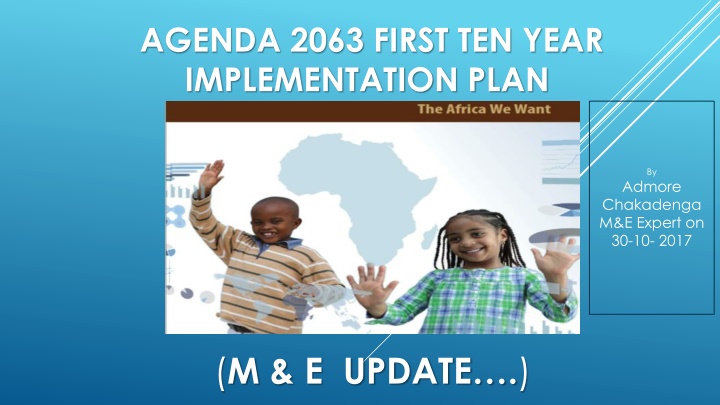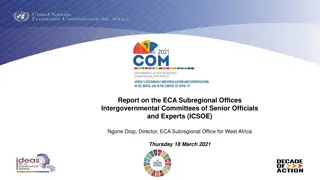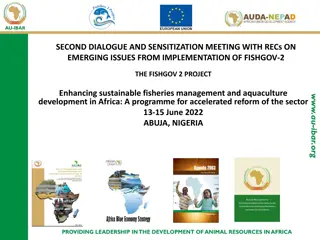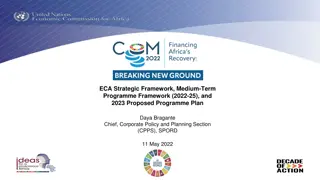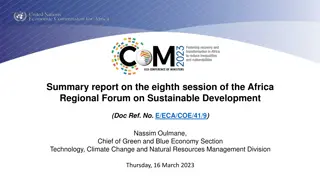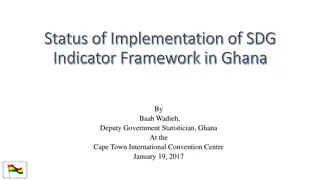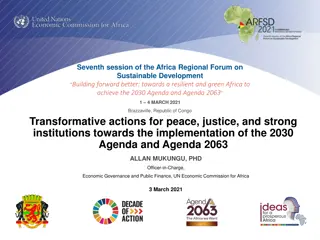AU Agenda 2063 First Ten-Year Implementation Overview
This presentation outlines the monitoring and evaluation framework for the African Union's Agenda 2063, focusing on accountability, reporting, and leveraging regional value. It discusses the framework's purpose, origins, components, and progress made in developing core indicators and implementation plans for the first ten years. The emphasis is on fostering convergence between Agenda 2063 and the Sustainable Development Goals (SDGs) while encouraging evidence-based learning and participation.
Download Presentation

Please find below an Image/Link to download the presentation.
The content on the website is provided AS IS for your information and personal use only. It may not be sold, licensed, or shared on other websites without obtaining consent from the author.If you encounter any issues during the download, it is possible that the publisher has removed the file from their server.
You are allowed to download the files provided on this website for personal or commercial use, subject to the condition that they are used lawfully. All files are the property of their respective owners.
The content on the website is provided AS IS for your information and personal use only. It may not be sold, licensed, or shared on other websites without obtaining consent from the author.
E N D
Presentation Transcript
AGENDA 2063 FIRST TEN YEAR IMPLEMENTATION PLAN By Admore Chakadenga M&E Expert on 30-10- 2017 (M & E UPDATE .)
PRESENTATION OUTLINE What is it? The AU A2063 M&E Framework: What is already done Indicator Handbook: Major components of indicator Profiles M&E Framework Snapshot Regional Value in the M&E of Agenda 2063 Outlook
African Union Commissio n The AU A2063 M&E Framework: What is The AU A2063 M&E Framework: What is it. it. Is a guiding document on monitoring, evaluation, accountability and reporting Guiding book Overarching Principles Implementation and Monitoring is primarily national responsibility Leverage Regional and Continental Value for enhanced action
African Union Commissio n Purpose Purpose Common M&E Framework for MS, RECs and AU Organs Reinforcing culture of accountability at all levels Measuring regional and continental value addition to national action Fostering convergence in M&E of the FTYIP and SDGs Encouraging evidence based learning Encouraging participation and ownership
African Union Commissio n Origins Origins Adoption of FTYIP by AU Summit in June 2015 Summit directives on M&E Technical Committee (AUC/NEPAD, RECs, ECA, AfDB, ACBF, APRM Validation Process
The AU A2063 M&E Framework: What is already done The AU A2063 M&E Framework: What is already done African Union Commissio n Draft M&E Framework & Indicator Handbook developed (May 2017) 63 Core Indicators Agreed to [Dec 2016] Validated by National Planning Experts Technical working formed First Ten-year A2063 Implementation Plan (Results Framework) [Jan 2015] Awaiting Approval by Policy Organs Widespread consultation AU Summit Commitment Decision on the A2063 vision in 2013 AUC, NEPAD, JSSO, AfDB, UNECA, ACBF, PAP, 8 RECs, ASSD, Mapping of Agenda 2063 and SDGs Measurable goals and targets (desired change/ impact; outcomes, outputs) Widespread roll out is the next step Political agenda
Convergence reminder Convergence reminder African Union Commissio n AGENDA 2063 FTYIP 7 Aspirations ; 20 Goals, 39 Priority Areas, 256 Targets, 242 (63 Core) Indicators Social Economic Political Sustainability Cultural Others 17 SDGs -169 Targets -231 Indicators Social Economic Sustainability etc
African Union Commissio n Mapping of the final list of indicators Mapping of the final list of indicators Goal 1: A High Standard of Living, Quality of Life and Well Being for All Corresponding SDG Indicator Priority Area Agenda 2063 Target Indicator Increase 2013 per capita income by at least 30% GNI per capita 8.1.1 Unemployment rate by age group, by sex, vulnerability Reduce 2013 unemployment rate by at least 25% 8.5.2 1. Incomes, Jobs and decent work Reduce Youth and Women unemployment rate by 2% per annum Reduce 2013 unemployment rate for vulnerable groups by at least 25% Reduce (Improve) the 2013 Gini coefficient by at least 20%. Reduce income inequality by at least 20% Reduce stunting in children to 10% and underweight to 5%. Reduce 2013 level of proportion of the population without access to safe drinking water by 95%. Gini coefficient 10.2.1 b) Prevalence of underweight among children under 5 2. Poverty, Inequality and Hunger 2.2.1 % of population with access to safe drinking water 6.1.1
Indicator Handbook: Major Components of Indicator Profiles African Union Commissio n 4. Data Collection Methods, Data Sources, Data Analysis & Reporting Methods and Frequencies 3. Unit of Measurement and Disaggregation 2. Indicator Computation Formula WHEN, WHERE & how: Defines freq. of data collection, analysis and reporting, incl. data limitations 1. Indicator description, relevance and definition of key terms Specifies unit by which magnitude is accounted for. Also allows for breakdown of data values into constituent parts HOW: standardising the computation of indicator values Focus is on WHAT & WHY
African Union Commissio n M&E Framework snapshot M&E Framework snapshot
African Union Commissio n Role of RECs in M&E of Agenda 2063 Role of RECs in M&E of Agenda 2063 Organize annual forum for member states to review regional monitoring and evaluation performance on FTYIP Facilitate/coordinate the preparation of an integrated regional M&E report on the implementation of the FTYIP by member states and regional programmes Strengthening national capacities for the monitoring and evaluation of FTYIP Facilitate/coordinate the assessment of the implementation effectiveness of the resource mobilization plans of member states on FTYIP execution
OUTLOOK WAYFORWARD Implementations of the FTYIP M&E Framework RECS to play the lead roles in the domestication the M&E Framework Strengthened Partnership between AUC/NEPAD/RECs and the UN System Consideration of additional SDG indicators and adoption by the EC Widespread role out including Working with RECs and MS to domesticate M&E Framework.
